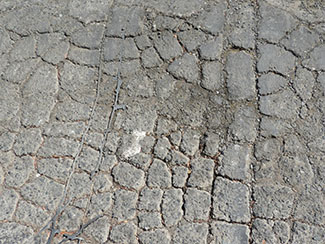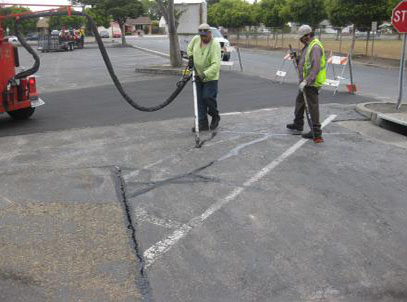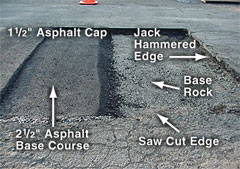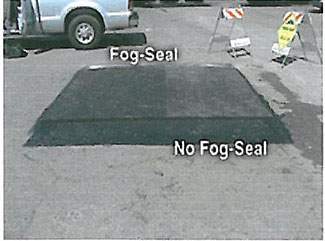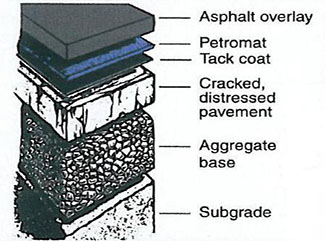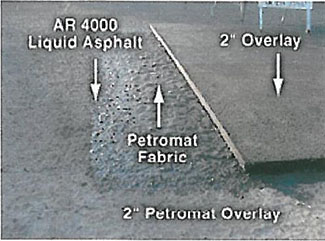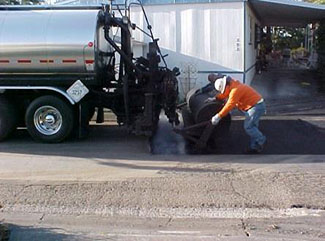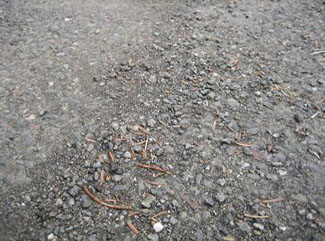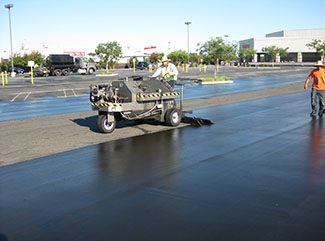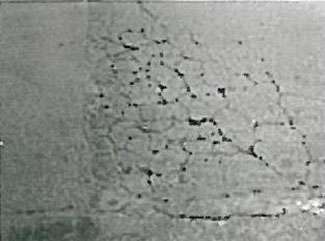Alligator Cracking
Alligator cracking is often used as our measure of failure. When pavement is failing we usually visualize area of alligator cracking and maybe a few potholes. Alligator cracking begins on the bottom of the pavement and is the result of de-flection or bending of the pavement under wheel load.
Asphalt Concrete
Plant mixed asphaltic concrete, well graded crushed aggregated with a smooth surface texture.
Crackfilling Hot & Cold
Hot Pour: Hot rubberized crackfiller is a hot applied, petroleum based product which is used to fill cracks in asphalt concrete pavements in warm to hot climates. When melted and properly applied Hot Pour forms a highly adhesive and flexible compound that resists cracking in the winter and is resistant to pick-up at summer temperatures.
Cold Pour: An emulsified petroleum asphalt and suitable fillers, modified with latex rubber. This cold-applied product is designed for use in filling cracks in asphaltic concrete pavements.
Cold Pour: An emulsified petroleum asphalt and suitable fillers, modified with latex rubber. This cold-applied product is designed for use in filling cracks in asphaltic concrete pavements.
Dig Outs
Localized pavement repairs to correct structural deficiencies. The pavement is saw-cut in rectangular patterns and all material within the rectangle is removed and replaced.
Fog Seal
A spray applied emulsified asphalt seal that is used as a seasonal winterizer to protect asphalt cement. Fog Seal usually consists of soft-based SS1-H and lasts only one season.
Full Depth Asphalt
A design methodology where the asphalt material provides the majority of the pavement structural support.
Overlay
The placement of asphaltic concrete mix over an existing asphaltic concrete or portland cement concrete surface.
Overlay with Petromat
Fabrics refer to a crack retardant fabric membrane placed on the existing surface of existing pavement under a new overlay.
Portland Cement Concrete
(PCC)
(PCC)
Aggregated with cement binder, characterized by gray/white color and relatively smooth, uniform concrete surface having few exposed aggregates.
Raveling
Raveling of the asphalt pavement is the gradual roughening of the surface texture. The fine sandy particles are “washing” away leaving the pavement with coarse rock on the surface and a much rougher texture than originally constructed.
Sealcoats
Sealcoats or maintenance seals are generic terms for any of a number of surface coatings or asphaltic sealers, all aimed at protecting against moisture intrusion and raveling. Common brands are TA-1000, Guardtop, Overkote, Sealmaster, etc.
Slurry Surfacing
(Cal-Trans 37.3)
(Cal-Trans 37.3)
Slurry Surfacing is an asphalt slurry mixture made from closely graded fine aggregate, emulsified asphalt and water, all carefully calibrated and mixed to form a mortar-like compound.
Type I: An emulsified asphalt, water and aggregate mixture with graded aggregates of 1/8″ added at the job site.
Type II: An emulsified asphalt, water and aggregate of 3/16″ with aggregates added at the job site.
Type III: An emulsified asphalt, water and aggregate of 3/8″ maximum size with aggregate added at the job site. Type III is not commonly used for anything but major highways and rural roadways.
Type I: An emulsified asphalt, water and aggregate mixture with graded aggregates of 1/8″ added at the job site.
Type II: An emulsified asphalt, water and aggregate of 3/16″ with aggregates added at the job site.
Type III: An emulsified asphalt, water and aggregate of 3/8″ maximum size with aggregate added at the job site. Type III is not commonly used for anything but major highways and rural roadways.
Tack Coat
A spray applied asphalt product used to promote bonding between new asphalt concrete and other surfaces. Most commonly used between asphalt concrete pavement layers.
Transverse Joint Block Cracking
Cracking of this nature is related to shrinkage. Shrinkage can be the result of temperature or, in rare instances the underlying soil. It is a non- structural defect and is more likely to form as the pavement hardens through oxidation. The major problem with this cracking is that it is unsightly and allows water into the soil layers, and if unsealed promotes structural failure.
Download the Glossary of Terms PDF

